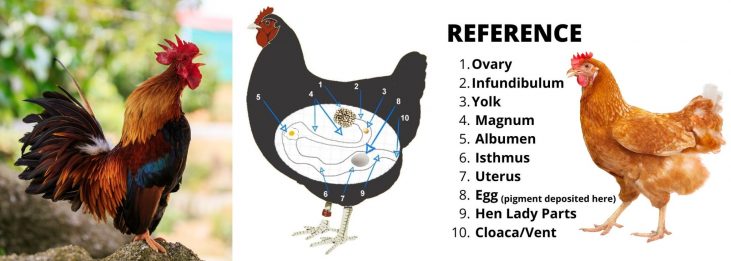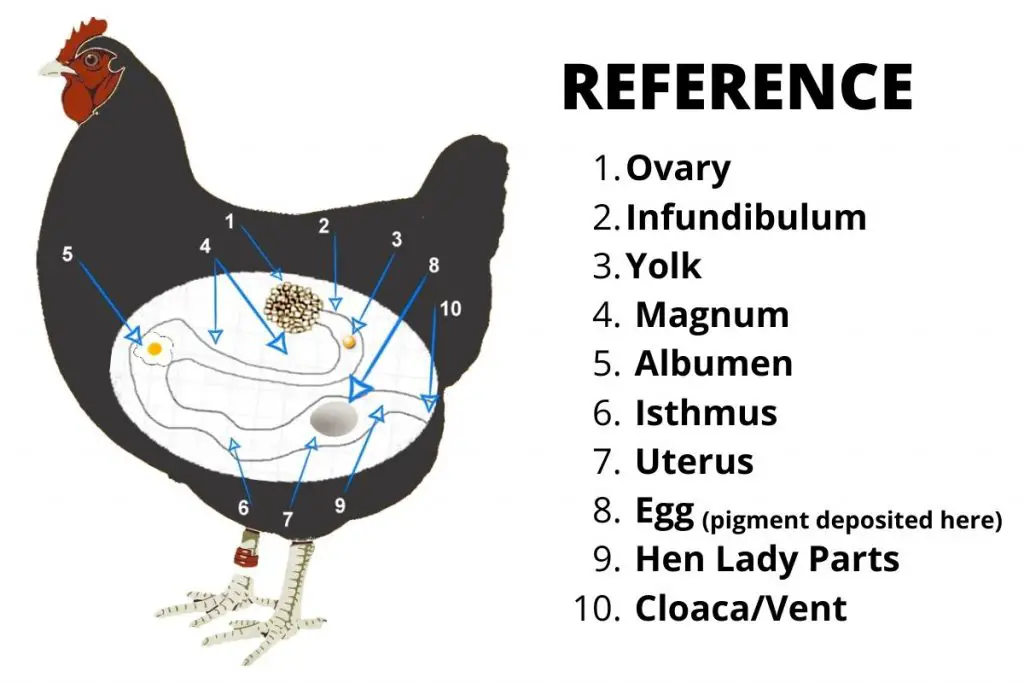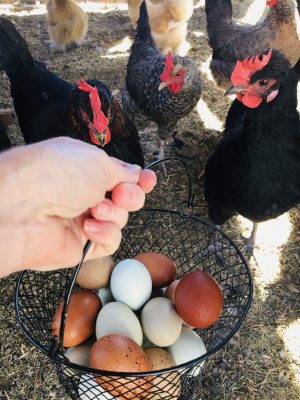

Increases egg laying naturally.
- Improves chicken health.
- Deters parasites: mites, lice, fleas, flies & rodents.
- On SALE!
- SHOP NOW
*(Refer to the chart below for a visual of the fascinating 26 hour journey of a chicken egg.)
From start to finish, it takes an egg approximately 26 hours to travel through a hens reproductive tract. This journey is a fascinating one, going through several developmental stages until it becomes what we know as an egg. It even receives a “coat of paint,” before being laid.
All eggs begin forming within a hens only functioning ovary (1). Unlike most animals that have two functioning ovaries, a hen only has one.
When a female baby chick hatches, the second ovary, the right ovary, stops developing. The one functioning ovary, her left one, continues to develop and contain several thousand tiny ova, each ovum contained within its own follicle.

A yolk (3) is released from a hens right ovary and travels through the infundibulum (2). This is the first part of the hens oviduct and is about 3-4 inches long. It remains here for approximately 15 minutes.
If a hen mated with a rooster, this is where and when fertilization takes place before traveling further down the oviduct.
The next 3 hours the yolk spends in the magnum (4) portion of the oviduct. The magnum is about 13 inches in length and is the longest part of the oviduct. This is where the white part of the egg, or albumen (5), is developed.
The next part of the oviduct is called the isthmus (6) and it is about 4 inches in length. This is where the inner and outer shell membranes are formed, taking about 75 minutes.
From there, it travels to the uterus (7) or “shell gland.” This section is about 4-5 inches long. This is where layer upon layer of shell is deposited. The shell is compromised mostly of calcium carbonate.

If a pigment (8) is to be released, giving egg its color, this is where it occurs. The egg remains here for about 20 hours, regardless of whether a pigment is deposited or not. Eggs that do not have a pigment deposited are white.
From here the egg enters (9), a thick muscle that is used to push the egg out. This is where the bloom or “cuticle” is formed. The bloom is a protective coating that seals the eggs pores, protecting it from bacteria entering the egg.
This is why you do not want to wash a farm fresh egg. Washing it will remove the bloom, making it more vulnerable to bacteria entering through its pores.
When the egg first enters here, it enters pointy side first. These muscles rotate the egg so it comes out large end first.
When a hen lays an egg, it will pass through her cloaca (10) or “vent.” This is the same area she excretes feces. But when she lays an egg, she will invert her oviduct, blocking any feces from contaminating the egg. Pretty amazing!
How Many Eggs Can a Chicken Lay in One Day?
Because it takes an egg approximately 26 hours to develop, it is only possible for a chicken to produce 1 egg a day. There is no way for a hen to produce more than this.

Chickens will lay at the most 1 egg a day, but most will not lay every single day.
A chickens reproductive system is stimulated by light. In order to begin producing eggs a hen needs around 14 hours of light.
This is why hens often have a decrease in their egg production during the time of the year when the days are shorter, in the fall and winter.
Hens pick up their laying when the days are longer, in the spring and summer months.
What Causes Two Yolks in One Egg?
Sometimes hens lay what is called a “double yolker,” or an egg that has two yolks. Hormonal imbalances can cause two yolks to be released close in succession, resulting in a “double yolker.”

Because double yolkers are usually produced due to hormonal imbalances, this is more commonly seen in new hens and hens that are at the end of their laying years.
When a hens ovary becomes overstimulated and produces two yolks close together, the result is two yolks being encapsulated inside one shell or egg.
Is it Safe to Eat a Double Yolk Egg?
It is perfectly fine to eat a double yolk egg. In fact, it is considered good luck to crack open a “double yolker” because only 1 in 1,000 eggs will contain two yolks!
FUN FACT: You will only find a double yolker in farm fresh eggs because supermarket eggs are weighed and candled prior to packaging. All double yolked eggs are discarded.
What Does It Mean When a Chicken Lays a Tiny Egg?
A tiny egg is laid when a hen doesn’t release a yolk before her body starts encapsulating it. This can happen with young hens or in hens that their reproductive cycle has been disturbed.

Tiny eggs that hens can lay have been called many different names such as “fairy eggs,” “wind eggs,” “fart eggs,” “witch eggs” and “dwarf eggs.” All of them refer to the same thing, a very small egg.
In a tiny egg, there often isn’t a yolk inside of it. Any breed of hen can lay one of these so they come in all different colors; brown, blue, white and green.

Stressful Situations Can Affect a Hens Reproductive Cycle
- extreme heat
- extreme cold
- lack of light
- lack of water
- inadequate diet
- predators
- parasite infestation
A hen that is under stress will not lay as frequently or may even stop laying completely. If you find that you are not getting as many chicken eggs, read my article: Why Do Chickens Stop Laying Eggs? 5 Important Tips for some great tips to get them laying again.
What is a Torpedo Egg?
Sometimes a hen will lay an egg that is long and narrow. They call these, “torpedo eggs.” This is usually seen in young hens with an immature egg shell gland or in a senior hen, close to her final days of laying. Hens that lay eggs like this routinely most likely have a defect in their egg shell gland.

Getting these egg on occasion is nothing to worry about. They may look silly, but are perfectly fine to eat.
If you find that your hen is laying “torpedo eggs” frequently, this is something to pay close attention to. A hen that lays these eggs routinely is more likely to become “egg bound.”
When a hen becomes egg bound, she is unable to lay the egg, due to it being “stuck” or egg bound. Eggs usually become stuck between the vent or “cloaca” and uterus or “shell gland.”
CONCLUSION: The 26 hour journey of a chicken egg is in fact very fascinating! It’s amazing how much work actually goes into the production of a chicken egg.
No matter what breed, a hen will not lay more than one egg a day.
Sometimes a hens egg reproduction can be affected by hormones or the environment causing her to lay a tiny egg, torpedo egg or an egg with two yolks.
While these eggs may look funny, they are all perfectly fine to eat!
What type of egg abnormalities have you seen with your flock?



I loved keeping chickens. <3 They are fascinating and entertaining little creatures. They all have such personalities, and my FAVORITE part was the soft little chattering cooing sounds they made when roosting at night.
Yes, I love their soft, little chattering and cooing sounds they make too! 😀